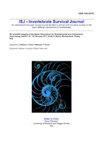The impact of zinc oxide nanoparticles in freshwater mussels exposed to municipal effluents
IF 1.2
4区 农林科学
Q4 IMMUNOLOGY
引用次数: 13
Abstract
Zinc oxide nanoparticles (nano-ZnO) are used in the production of transparent sunscreens and cosmetics, which are released into the environment through municipal effluents. The purpose of this study was to examine the toxicity of nano-ZnO to freshwater mussels (Elliptio complanata) in the presence of municipal effluents. Mussels were exposed for 21 days at 15 o C to 1 and 10 µg/L nanoZnO, and ZnCl2 in the presence of a physico-chemically treated municipal effluent (3 and 10 % v/v). After the exposure period and a 24 h depuration step, mussels were analyzed for free Zn in gills, metallothioneins (MT), oxidative stress (production of malondialdehyde (MDA) during lipid peroxidation), gonad alkali-labile phosphate (ALP) levels and genotoxicity. Gill MT levels were increased at 10 µg/L nano-ZnO and ZnCl2 and in the presence of the municipal effluent. MT levels were positively correlated with free Zn in gills and negatively correlated with MDA levels, indicating its involvement in the prevention of oxidative stress. However, MDA levels were significantly related to DNA damage in gills, indicating that MT induction did not prevent oxidative-mediated damage in cells. Gonad ALP levels were increased by exposure to ZnCl2 and to the highest concentration of municipal effluent. DNA strand breaks were increased in mussels treated to nano-ZnO indepentely of municipal effluent. Multivariate discriminant function analysis revealed that control mussels differed from mussels exposed to the municipal effluent and from those exposed to nano-ZnO or ZnCl2 alone. When the municipal effluent was added, changes in MDA, MT and labile Zn were produced and formed another cluster, suggesting a change in the toxicity of the municipal effluent in the presence of nano-ZnO.氧化锌纳米颗粒对城市污水中淡水贻贝的影响
氧化锌纳米颗粒(纳米氧化锌)用于生产透明防晒霜和化妆品,这些产品通过城市污水排放到环境中。本研究的目的是研究纳米氧化锌在城市污水中对淡水贻贝(Elliptio planata)的毒性。在15℃条件下,将贻贝暴露于1µg/L和10µg/L纳米zno和ZnCl2中21天,其中存在物理化学处理过的城市污水(3和10% v/v)。在处理和净化24 h后,分析贻贝鳃中游离锌、金属硫蛋白(MT)、氧化应激(脂质过氧化过程中丙二醛(MDA)的产生)、性腺碱不稳定磷酸盐(ALP)水平和遗传毒性。在10 μ g/L纳米zno和ZnCl2存在的情况下,吉尔MT水平升高。MT水平与鳃中游离Zn呈正相关,与MDA水平呈负相关,表明其参与了氧化应激的预防。然而,MDA水平与鳃DNA损伤显著相关,表明MT诱导并不能阻止细胞氧化介导的损伤。性腺ALP水平因暴露于ZnCl2和最高浓度的城市污水而增加。与城市污水无关的纳米氧化锌处理贻贝DNA链断裂增加。多变量判别函数分析表明,对照贻贝与城市污水处理贻贝、纳米氧化锌或氯化锌单独处理贻贝存在差异。在城市污水中加入纳米氧化锌后,产生MDA、MT和活性Zn的变化并形成另一个簇,说明纳米氧化锌存在时城市污水的毒性发生了变化。
本文章由计算机程序翻译,如有差异,请以英文原文为准。
求助全文
约1分钟内获得全文
求助全文
来源期刊

ISJ-Invertebrate Survival Journal
IMMUNOLOGY-ZOOLOGY
CiteScore
2.10
自引率
0.00%
发文量
0
审稿时长
>12 weeks
期刊介绍:
Invertebrate Survival Journal (ISJ) is an international and open access journal devoted to prompt and innovative studies on the basic defense mechanisms in invertebrates, in particular with a view to identifying biotechnologies able to act against derived diseases and related economic damage.
Contributions will be mainly in the form of Letters to the Editor, Visions and Perspectives, Short Communications, Technical Reports, Research Reports, Review, Minireview and Reports of Meetings. Letters to the Editor can be commentaries or perspectives on invertebrate defence mechanisms or replies to the data published in ISJ.
 求助内容:
求助内容: 应助结果提醒方式:
应助结果提醒方式:


